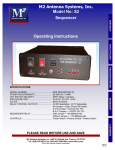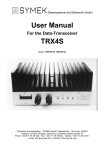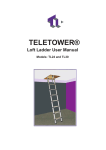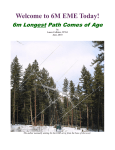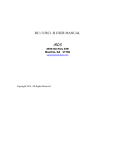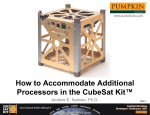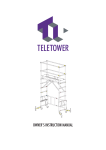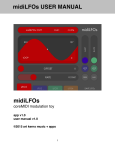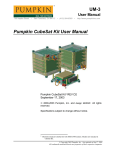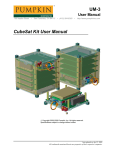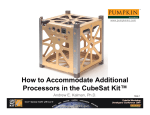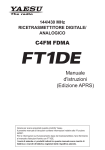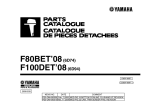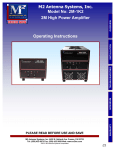Download "user manual"
Transcript
Development of a Ground Station (GS) Package Suited for Spacecraft Operation Control and Optimization for Satellite Flyby over the Ground Station HCTL Open Thesis and Dissertation Repository Series in Engineering and Technology Master Thesis Raj Gaurav Mishra Faculty Member The ICFAI University - Dehradun, Uttarakhand (India) 23 June 2014 HCTL Open Thesis and Dissertation Repository (HCTL Open TDR) HCTL Open Thesis and Dissertation Repository (HCTL Open TDR) Year 2014 Title Information Development of a Ground Station (GS) Package Suited for Spacecraft Operation Control and Optimization for Satellite Flyby over the Ground Station by Raj Gaurav Mishra. Date of Online Publishing: 23-June-2014 About this e-Book This e-book is a Master Thesis submitted by Raj Gaurav Mishra to the Department of Informatics VII - Robotics and Telematics, Julius Maximilians University of Wuerzburg (Germany) in the year 2007. Copyright and License Information c Copyright of this e-book retains with author(s) and their respective organization(s). This e-book is an open-access document distributed under the terms and conditions of the Creative Commons Attribution-NonCommercial 3.0 License. (http://creativecommons.org/licenses/by-nc/3.0/). Publisher Published by: HCTL Open Publications Solutions, Bhopal, MP, India Email: [email protected], editor [email protected] Website: http://tdr.hctl.org/ Bibliographic Information ISBN-13 (PDF version): 978-1-62951-608-0 ISBN-10 (PDF version): 1-62951-608-2 Unique Reference No.: TDR MThesis 201406001 e-Version (Online) available at: www.hctl.org/tdr/2014/TDR_MThesis_201406001.pdf Cite this e-Book as: Raj Gaurav Mishra, Development of a Ground Station (GS) Package Suited for Spacecraft Operation Control and Optimization for Satellite Flyby over the Ground Station, Master Thesis, HCTL Open Thesis and Dissertation Repository, ISBN (PDF version): 978-1-62951-608-0. HCTL Open Publications Solutions, India e-ISBN (PDF version): 978-1-62951-608-0 Dedicated to my Loving Grand-Parents & Parents with Heartfelt Gratitude and Love... Development of a GS Package suited for Spacecraft Operation Control and Optimization methods for Satellite flyby over the Ground Station. Raj Gaurav Mishra January 12, 2007 Abstract Development of a Ground Station Package suited for Spacecraft Operation Control and Optimization methods for Satellite flyby over the Ground Station is a Master thesis project done at “Julius Maximilian University of Wuerzburg, Department of Informatics VII- Robotics and Telematics, Germany” from June to Dec 2006. The CubeSat satellite ground station at the University of Wuerzburg is built with “commercial of the shelf” low cost amateur radio hardware. It opens up opportunities for students to receive and operate CubeSats, including Wuerzburgs UWE-1. As any other satellite ground station, it is built up on essential hardware, as there are Antenna, Antenna Rotator, Radio, Modem and Computers. Furthermore software is used to afford basic control over the ground station and provide tracking abilities to follow a satellite passing over the ground station. The main aim of this project is to redesign the ground station system for satellite tracking and to overcome the related problems of the existing system. Contents 1 Introduction 6 1.1 Old design of the Ground Station . . . . . . . . . . . . . . . . 9 1.2 Ground Station Structural Study . . . . . . . . . . . . . . . . 10 1.3 New Planned Structure . . . . . . . . . . . . . . . . . . . . . . 13 2 Construction 2.1 Hardware Specifications . . . . . . . . . . . . . . . . . 2.1.1 Hummel Teletower Jumbo III . . . . . . . . . . 2.1.2 Antennas . . . . . . . . . . . . . . . . . . . . . 2.1.3 Yaesu G-5500- Azimuth-Elevation Rotator and troller . . . . . . . . . . . . . . . . . . . . . . . 2.1.4 Rotator Plate . . . . . . . . . . . . . . . . . . . 2.1.5 Rotator-Computer Interface . . . . . . . . . . . 2.1.6 Cabling . . . . . . . . . . . . . . . . . . . . . . 2.1.7 Preamplifiers . . . . . . . . . . . . . . . . . . . 2.1.8 Transceiver - IC-910H and TNC4e . . . . . . . . 2.2 Software Specifications . . . . . . . . . . . . . . . . . . 2.2.1 Nova for Windows . . . . . . . . . . . . . . . . 2.2.2 Die Funkbox - WinRotor XP . . . . . . . . . . 2.2.3 Why Windows XP..?? . . . . . . . . . . . . . . 15 . . . . 15 . . . . 16 . . . . 17 Con. . . . 20 . . . . 21 . . . . 23 . . . . 25 . . . . 25 . . . . 26 . . . . 29 . . . . 29 . . . . 31 . . . . 35 3 Testing and Optimization of Ground Station 37 3.1 Testing Summary . . . . . . . . . . . . . . . . . . . . . . . . . 38 4 Conclusion 39 Appendices 39 A Hardware Documentation 40 B Configurations for “Nova for Windows”. 43 1 C Test Results 52 Bibliography 64 2 List of Figures . . . . . . . . . . . . . . . . . . . . . . . . . . . . . . . . . 9 . 11 . 13 . 14 Hummel Teletower Jumbo III. . . . . . . . . . . 2 m Antenna . . . . . . . . . . . . . . . . . . . 70 cms Antenna . . . . . . . . . . . . . . . . . . Yaesu G-5500 Rotator and Controller. . . . . . Rotator Plate - Old design. . . . . . . . . . . . Rotator Plate - New design. . . . . . . . . . . . WinRotor Computer Interface. . . . . . . . . . . Preamplifiers. . . . . . . . . . . . . . . . . . . . Specifications of Transceiver - IC910H. . . . . . Nova for Windows . . . . . . . . . . . . . . . . WinRotorXP - General Configuration. . . . . . WinRotorXP - Rotator Calibration. . . . . . . . WinRotorXP - Tracking Modus. . . . . . . . . . WinRotorXP - Tracking and Parking Positions. WinRotorXP - Satellite Tracking with NOVA. . . . . . . . . . . . . . . . . . . . . . . . . . . . . . . . . . . . . . . . . . . . . . . . . . . . . . . . . . . . . . . . . . . . . . . . . . . . . . . . . . . . . . . . . . . . . . . . . . . . . . . . . . . . . . . . . . . . . . . . . . 1.1 Old design of the Ground Station. . . . 1.2 Ground Station Structural Study. . . . 1.3 New design of the Ground Station. . . 1.4 Block Diagram of the Ground Station. 2.1 2.2 2.3 2.4 2.5 2.6 2.7 2.8 2.9 2.10 2.11 2.12 2.13 2.14 2.15 . . . . . . . . . . . . . . . . 17 18 20 22 22 24 24 26 28 29 32 33 34 35 36 A.1 Connections at Yaesu Rotator and Controller. . . . . . . . . . 41 B.1 B.2 B.3 B.4 B.5 B.6 B.7 B.8 B.9 Nova Nova Nova Nova Nova Nova Nova Nova Nova for for for for for for for for for Windwos Windows Windows Windows Windows Windows Windows Windows Windows - Configuring View. . . . Configuring Observer. . Configuring Satellites. . TLE Updation . . . . . Current View Observer. Current View Satellite. Satellite Footprints. . . Floating Toolbar. . . . Satellite Script. . . . . . 3 . . . . . . . . . . . . . . . . . . . . . . . . . . . . . . . . . . . . . . . . . . . . . . . . . . . . . . . . . . . . . . . . . . . . . . . . . . . . . . . . . . . . . . . . . . 44 44 45 46 46 47 47 48 49 B.10 Nova for Windows - Frequency Display. . . . . . . . . . . . . . 50 B.11 Nova for Windows - Antenna-Rotator Setup. . . . . . . . . . . 51 B.12 Nova for Windows - Further Help. . . . . . . . . . . . . . . . . 51 C.1 Test C.2 Test C.3 Test C.4 Test C.5 Test C.6 Test C.7 Test C.8 Test C.9 Test C.10 Test Beacons Beacons Beacons Beacons Beacons Beacons Beacons Beacons Beacons Beacons on 08Dec2006. on 11Dec2006. 12Dec2006. . . on 13Dec2006. on 13Dec2006. on 14Dec2006. on 14Dec2006. on 15Dec2006. on 18Dec2006. on 18Dec2006. . . . . . . . . . . 4 . . . . . . . . . . . . . . . . . . . . . . . . . . . . . . . . . . . . . . . . . . . . . . . . . . . . . . . . . . . . . . . . . . . . . . . . . . . . . . . . . . . . . . . . . . . . . . . . . . . . . . . . . . . . . . . . . . . . . . . . . . . . . . . . . . . . . . . . . . . . . . . . . . . . . . . . . . . . . . . . . . . . . . . . . . . . . . . . . . . . 53 54 56 57 58 59 60 62 63 64 List of Tables 7 1.1 New Ground Station Specifications. . . . . . . . . . . . . . . . 2.1 2.2 2.3 2.4 2.5 2.6 2.7 2.8 2.9 2.10 Hardware Specifications Table. . . . . . . . . . . . . . Hummel Teletower Jumbo III. . . . . . . . . . . . . . Parking Position. . . . . . . . . . . . . . . . . . . . . 2 meter Antenna Specifications. . . . . . . . . . . . . 70 cms Antenna Specifications. . . . . . . . . . . . . Yaesu G-5500 Rotator and Controller’s Specifications. Specification Table - Preamplifier LNA 145 MK II. . Specification Table - Preamplifier LNA 435 MK II. . Specifications Table - TNC4e. . . . . . . . . . . . . . Software Specifications Table. . . . . . . . . . . . . . . . . . . . . . . . . . . . . . . . . . . . . . . . . . . . . . . . . . . . . . . . . . . . . . . . 15 16 16 19 21 23 25 26 27 29 A.1 A.2 A.3 A.4 Connections Connections Connections Connections C.1 Testing C.2 Testing C.3 Testing C.4 Testing C.5 Testing C.6 Testing C.7 Testing C.8 Testing C.9 Testing C.10 Testing C.11 Testing - at at at at Rotator Controller. . Rotator Controller. . Rotator’s Metal Plug. Rotator’s Metal Plug. Satellite Satellite Satellite Satellite Satellite Satellite Satellite Satellite Satellite Satellite Satellite Script Script Script Script Script Script Script Script Script Script Script 08Dec2006. 11Dec2006. 11Dec2006. 12Dec2006. 13Dec2006. 13Dec2006. 14Dec2006. 14Dec2006. 15Dec2006. 18Dec2006. 18Dec2006. 5 . . . . . . . . . . . . . . . . . . . . . . . . . . . . . . . . . . . . . . . . . . . . . . . . . . . . . . . . 40 40 41 42 . . . . . . . . . . . . . . . . . . . . . . . . . . . . . . . . . . . . . . . . . . . . . . . . . . . . . . . . . . . . . . . . . . . . . . . . . . . . . . . . . . . . . . . . . . . . . . . . . . . . . . . . . . . . . . . . . . . . . . . . . . . . . . . . . . . . . . . . . . . . . . . . . . . . . . . . . . 52 53 53 55 55 57 58 59 61 62 63 Chapter 1 Introduction Ground Station at University of Wuerzburg. Department of Informatics VII is situated at the east of Wuerzburg on a hill, which is approximately 310 meters above the river “Main” level. The antenna tower is situated on the Department’s roof which is infact a most suitable position to operate the Ground Station. The satellite ground station at the University of Wuerzburg is built with “commercial off the shelf” low cost amateur radio hardware. It opens up opportunities for Students to operate CubeSats. As any other satellite ground station, it is built upon essential hardware, as there are Antenna, Antenna Rotator, Radio, and Modem. Furthermore software is used to afford basic control over the ground station and provide tracking abilities to follow a satellite passing over the ground station. The basic ground station is composed of 4 main components, an Antenna with antenna rotator, a Radio, a Modem and Computer. Each of these devices fulfils essential operations. 1. Antenna. An antenna is an arrangement of electrical conductors designed to transmit or receive radio waves which is a class of electromagnetic waves. It is mounted upon a rotator, which provides the possibility to move the antenna to any position by editing its azimuth- and elevation angle. This antenna rotator is further connected with computer to provide the automatic tracking. 2. Radio. The Radio makes it possible to transmit- and receive-signals from the Antenna. 6 Ground Station Name University Latitude Longitude City Country Altitude Tower Operating frequencies One 2 meter antenna One 70 cms antenna Antenna rotator Rotator controller Rotator-Computer Interface Rotator-Computer Interface driver Tracking software Radio Polarisation switch Preamplifiers Tranceiver Power Supply Two PCs UWE-UWZ University of Wuerzburg, Germany 49o 470 49.20”/49, 797deg.N orth 9o 560 56.40”/9, 949deg.East Wuerzburg Germany 310 meters Hummel Teletower Jumbo III 2m and 70 cms amateur bands M2 2MCP22 M2 436CP42U/G Yaesu G-5500 Yaeau G-5500 controller WinRotor WinRotor XP NOVA for Windows TNC4e WiMO LNA-145, SLN Series ICOM IC-910H Microset 13.5 Volts Fujitsu Siemens Table 1.1: New Ground Station Specifications. 3. Modem. A modem (from modulate and demodulate) is a device that modulates an analogue carrier signal to encode digital information, and also demodulates such a carrier signal to decode the transmitted information. The goal is to produce a signal that can be transmitted easily and decoded to reproduce the original digital data. Modem is used to transmit or receive analog signals, from radio. 7 4. Computer. One or more computers for steering the hardware and for the administration of the sent and received data. For manual control and automatic tracking purposes, Wuerzburg’s satellite ground station is endowed with ground station satellite tracking software. 8 1.1 Old design of the Ground Station There were two 70cm antennas and two 2m antennas in the old design of the ground station. The antennas were mounted in an H-construction in a way to provide a uniform distribution of the weight on the rotator. This construction consists of three supporting rods. The central bar was manufactured from aluminium and was 6 meters long. This H-construction was installed on a metal plate, which served as connecting piece between rotator and antenna construction. The Rotator used was EGIS EPSR-203 mod, and the rotator controller used was EGIS EPS-103. Figure 1.1: Old design of the Ground Station. Related problems The University of Wuerzburg’s Ground Station was unable to work perfectly with respect of the Satellite flyby time of approx about 12-15 min. The rotator was weak and was unable to move in speed to track the satellite 9 in a suitable time. The second problem was with the satellite passes with high elevations, the antenna rotator was unable to track them. One of the clear reasons was the weight of the Antenna assembly associated with the malfunctioning of the Antenna Rotor. Also there were some problems associated with the cabling pattern of the Antenna wires of the ground station system. The need was to start with a detailed research study of the other CubeSats Ground Stations in order to see what could be the best possible structure so that the new design of the Antenna-Rotator system can auto track satellites, with combination of some satellite tracking software. 1.2 Ground Station Structural Study The GS structural study survey was made to get an idea about the existing structure of various Ground Stations around the world, made for tracking CubeSat satellites. The selection of a suitable antenna rotator was one of the important aim for this study. There were two possibilities of using the antenna rotator. The first idea was to use two different rotators for the azimuth and elevation control, and the second was to use a single rotator which can provide the azimuth and elevation movement all together like old antenna rotator “EGIS EPSR-203 mod” used in the Ground Station. The options were: 1. Creative ERC5A, elevation antenna rotator. 2. Creative RC5A, azimuth antenna rotator. 3. Creative RC5B-3P, azimuth antenna rotator. 4. Yaesu G-550, elevation antenna rotator. 5. Yaesu G-2300DXA, azimuth antenna rotator. 6. Yaesu G-5500, azimuth and elevation rotator. 7. Emotator EV-800D, elevation rotator. 10 Figure 1.2: Ground Station Structural Study. 11 For the Ground Station at University of Wuerzburg the antenna structure is situated on a tower, for ease in maintenance and installation a single rotator for both elevation and azimuth control is selected. Yaesu G-5500 Azimuth and Elevation rotator is fast, light weight and maintenance free and is available with three possible options of computer interfaces: Yaesu G-232A or GS-232B, Uni-trac computer interface and WinRotor computer interface. Out of these options, “WinRotor” was easily available and came up with driver software “WinRotor XP” to control antenna rotator. More about Yaesu G-5500 and WinRotor Interface, specifications are available in chapter two. 12 1.3 New Planned Structure Figure 1.3: New design of the Ground Station. The new planned structure had many changes as compared to the Old structure. It has two antennas in place of four, one 2 meter and one 70 cm antenna to reduce the wait of the antenna assembly on the rotator to increase the rotator efficiency and speed. After studying the “Yaesu G-5500” rotator’s specifications and the performance details from the internet, it is selected as a new rotator and controller for the ground station at Department of Informatics VII, University of Wuerzburg. The next selection was about the computer interface for the Yaesu G-5500 rotator. The easy availability of the computer interface leads us to go with “WinRotor computer interface for G-5500/K-5500”. It comes with the driver software WinRotor XP. 13 “Nova for Windows” was the new selected satellite tracking software. The reason was the compatibility of this software with the WinRotor computer interface for automatic satellite tracking. Also Nova for Windows provides live update from Internet and is easy to configure. Figure 1.4: Block Diagram of the Ground Station. Department of Informatics VII- “Robotics and Telematics” at the University of Wuerzburg is the financing body for this Ground Station project. 14 Chapter 2 Construction Construction followed in two parts, first one covered the “Hardware and Electronics” and the second covered the “Software” requirements of the GS Package. 2.1 Hardware Specifications Altitude Tower Operating frequencies One 2 meter antenna One 70 cms antenna Antenna rotator and Controller Rotator-Computer Interface Rotator-Computer Interface driver Radio Polarisation switch Preamplifiers Tranceiver Power Supply Two PCs 310 meters Hummel Teletower Jumbo III 2m and 70 cms amateur bands M2 2MCP22 M2 436CP42U/G Yaesu G-5500 WinRotor WinRotor XP TNC4e WiMO LNA-145, SLN Series ICOM IC-910H Microset 13.5 Volts Fujitsu Siemens Table 2.1: Hardware Specifications Table. 15 2.1.1 Hummel Teletower Jumbo III The Hummel Tower is the main base of the Ground Station, which is located on the roof of the Department of Informatics VII- Robotics and Telematics, at University of Wuerzburg, Germany. It provides the platform to the GS to perform the tracking and telemetry operations. The Hummel Teletower lifts the antennas up to a height of approximately 12 meters above the roof terrace, with which the antenna achieves its own functional height. A transportation carriage is installed to the Teletower, which carries entire antenna construction including the antenna rotator. On the back of the transportation carriage a switchbox is installed, which can be moved together with the carriage and in which some electronic components necessary for the signal receptions such as Preamplifiers are accommodated. Hummel Al-Towers Teletower Jumbo III 310 meters Manufacturer Model Number Altitude Table 2.2: Hummel Teletower Jumbo III. The antenna assembly is moved down with the help of transportation carriage when not in use, to a park position, which is on roof height and at which antennas are not exposed to strongly arising storms. The Parking Position is: Azimuth Elevation 90 Degrees 120 Degrees Table 2.3: Parking Position. Parking position is for maintenance and repair work and for the protection of the antennas against strong wind and weather. The software at the Ground 16 Figure 2.1: Hummel Teletower Jumbo III. Station is set to bring the antennas to their Parking positions, immediately after quitting the tracking application. 2.1.2 Antennas The ground station of the Informatics VII, University of Wuerzburg, is equipped with two antennas of the company M2. The two antennas works in the 2m and in the 70cm frequency bands. 17 M2 Products of this company belong in the range of the amateur radio technology and are the qualitatively best products and permit very good straight receiving powers within the satellite communication service range The 2 meter antenna is M2 2MCP22. This cross polarized yagi was computer designed for the serious OSCAR user. The average side and back lobes power have been reduced by approximately 10 dB over any previous design, enhancing signal to noise ratio and putting all your power where it will do the most good. The 2MCP22 is ideal for general use over the entire two meter band. The unique Driven Element Modules are CNC machined and feature O-ring sealed connectors. Internal connections are encapsulated in a space age silicone gel with nearly 4 times the dielectric strength of air. The 2MCP22 is the finest circular polarized antenna. Figure 2.2: 2 m Antenna The 70 centimetre antenna is M2 436CP42U/G. The 436-CP42 U/G (Ultra-Gain) sets a new performance standard for UHF circular polarized antennas. Gain and Feedback are excellent. The boom length is matched to the 2MCP22, and together they form an unbeatable satellite communications package. The extremely clean pattern maximizes forward gain and feedback. The pattern is important in order to match the antennas noise temperature with modern low-noise preamps. The driven 18 2 m Antenna Manufacturer Model Frequency range Gain @ 145.9 MHz Front to back Beamwidth Feed impedance VSWR Input Connector Power Handling Stacking Distance Boom length Boom Diameter Elements/Type Turning radius Wind Area Weight/ShipWt. M2 2MCP22 M2 Antenna Systems, Inc. 2MCP22 144 TO 148 MHz 12.25 dBdc 25 dB Typical 38 50 Ohms Unbal. 1.4: Max ’N’ Female 1.5 KW 9.5 to 10 feet 18’7” 1-1/2, Tapering to 1” 22/3/16” Alum Rod 10 ft. 2.5 sq.ft 12.5 lbs 14 lbs UPS Table 2.4: 2 meter Antenna Specifications. element and ’T’ blocks are CNC machined, with connectors O-ring sealed for low maintenance and long-term peak performance. For further specifications refer Table 2.4 and 2.5. The minimum distance between the antennas should be 1 meter for distortion free transmission and reception of the signals, but to keep the movement of the antennas flexible enough up to 360 degrees in azimuth, both of the antennas are mounted on a six meters long aluminium rod keeping the antennas four meters apart. 19 Figure 2.3: 70 cms Antenna 2.1.3 Yaesu G-5500- Azimuth-Elevation Rotator and Controller The Yaesu G-5500 provides 450 degrees azimuth and 180 degrees elevation control of medium and large sized unidirectional satellite antenna arrays under remote control from the station operating position. The two factory-lubricated rotator units are housed in weatherproof melamine resin coated die-cast aluminium, to provide maintenance-free operation under all climatic conditions. The rotators may be mounted together on a mast, or independently with the azimuth rotator inside a tower and the elevation rotator on the must. The controller unit is a desktop unit with dual meters and direction controls for azimuth, in compass direction and degrees and elevation, from 0 to 180 degrees. An external control jack is provided on the rear of the controller for interfacing via D-to-A converters to an external microcomputer or other display/controller. The Yaesu G5500 requires two six conductor control cables. The rear panel of the control box has six screw terminals for azimuth and six terminals for elevation. Two 7 conductor metal plugs with weather-boots are included. These two plugs will require careful soldering. It is important to test the 20 70 cm Antenna Manufacturer Model Frequency range Gain @ 145.9 MHz Front to back Beamwidth Polarity Ellipticity Feed impedance VSWR Input Connector Power Handling Turning radius Wind Area Mast Size Weight/ShipWt. M2 436CP42U/G M2 Antenna Systems, Inc. 2MCP22 430 - 438 MHz 16.8 dBdc 25 dB Typical 21 circular Circular, RHC or LHC 1.5 dB Typical 50 W, Unbalanced 1.5:1 and better ’N’ Female 1.0 KW 88” El, 138” Az 2 sq.ft. 1.5 to 2 Inches 7.8 lbs /10 lbs UPS Table 2.5: 70 cms Antenna Specifications. rotator and wirings on the ground, before installing it on the tower. Please refer Appendix B for the connection documentation. 2.1.4 Rotator Plate The antenna rotator Yaesu G-5500 is installed onto a metal plate, which serves as connecting piece between rotator and Hummel Teletower. This metal plate guarantees a fixed connection between the antenna rotator and the Hummel Teletower. Thus will at the same time structurally separate the antenna construction from the Hummel Teletower. The old rotator’s plate is redesigned for the new rotator with few modifications as per requirement. Figures 2.5 and 2.6 can more illustrate it. 21 Figure 2.4: Yaesu G-5500 Rotator and Controller. Figure 2.5: Rotator Plate - Old design. This plate is fixed on the tower using M10 screws which provides it stability to hold the rotator and antenna while the tracking movement. 22 Power Supply Voltage Power Supply Current Consumption Rotor Voltage Cable Conductors Required Rotation Time (Non Loaded) Rotation Time (Non Loaded) Rotation Range Rotation Torque Rotation Torque Braking Torque Braking Torque Maximum Vertical Load Maximum Vertical Load Mast Outside Diameter Boom Outside Diameter Braking Type Wind Loading Area Maximum Continuous Duty Operating Temperature Range Operating Temperature Range Rotator Dimension Rotator Weight Controller Dimension (WHD) Controller Weight 117 VAC, 50-60 Hz 120 VA 24 VAC 6 and 6 Elevation (180): 67 sec at 60 Hz Azimuth (360): 58 sec at 60 Hz Elevation: 180, Azimuth: 450 Elevation: 101 foot-pounds (14 kg-m) Azimuth: 44 foot-pounds (6 kg-m) Elevation : 289 foot-pounds (4 kg-m) Azimuth: 289 foot-pounds (4 kg-m) Elevation: 30 kg or less Azimuth: 440 Lbs. (200 kg) or less 1.5-2.5 inches (38 to 63mm) 1.24-1.675 inches (32 to 43mm) Mechanical and Electrical stoppers 1.0 square meter or less 5 minutes 0 deg C to +40 deg C (Controller) -20 deg C to +40 deg C (Rotator) 10x13.75x7.5 inches 20 Lbs (9 kg) 200 x 130 x 193 mm 6.6 Lbs (3 kg) Table 2.6: Yaesu G-5500 Rotator and Controller’s Specifications. The Yaesu G-5500 is attached on the top of the rotator plate using M8 screws. 2.1.5 Rotator-Computer Interface The computer Interface for the Yaesu G-5500 rotator controller is “Die Funkbox - WinRotor”. It provides an USB connection to the computer. Yaesu G-5500 23 Figure 2.6: Rotator Plate - New design. controller and WinRotor Interface is shown in figure 2.7. Figure 2.7: WinRotor Computer Interface. 24 2.1.6 Cabling Cabling pattern is another basic requirement of the Ground Station. This is important to bind the Antenna and Rotator cables in a pattern, so that it will not stuck at any time during the tracking operation of 0-360 degrees azimuth and 0-180 degrees elevation movements all together. 2.1.7 Preamplifiers The LNA series for 2 m and 70 cm has a silver plated brass housing and a tuneable nand pass filter with air coils and high Q trimmers at the output. The amplifiers are not used only for amateur radio but on different frequencies also for professional applications, for example in radio astronomy, as preamplifiers in company radio networks and for increasing the sensitivity of repeaters. In addition to the extremely low noise figure also the good electrical stability (no self-excitation) should be emphasised as well as the very large signal behaviour. Preamplifier Specifications: LNA 145 MK II Frequency Range Noise Figure, typical @ 20 deg.C Gain, typical Socket Operating Voltage Current Drain Dimensions Weight 144 - 148 MHz 0.2 dB 23 dB N-Female 15 V DC 25 mAmp 74 x 56 x 30 mm 150 gms Table 2.7: Specification Table - Preamplifier LNA 145 MK II. 25 Figure 2.8: Preamplifiers. LNA 435 MK II Frequency Range Noise Figure, typical @ 20 deg.C Gain, typical Socket Operating Voltage Current Drain Dimensions Weight 430 - 440 MHz 0.25 dB 22 dB N-Female 15 V DC 25 mAmp 74 x 56 x 30 mm 150 gms Table 2.8: Specification Table - Preamplifier LNA 435 MK II. 2.1.8 Transceiver - IC-910H and TNC4e The IC-910H is an all mode satellite radio. It is compact and lightweight for field operation. The IC-910H features a powerful 100 W of output on 2 meter band, and 75 W on 430/440 band provided by the newly designed power amplifier circuit, which employs bipolar transistors in parallel. The combination of the aluminium die-cast chassis and effective cooling fan ensures stable output for continuous operation. 26 In the satellite mode, the downlink and uplink frequencies are displayed simultaneously on the main and sub bands respectively. Doppler shift compensation is also available. Up to ten satellites memory channels are there to store uplink downlink frequencies and operating mode. Also the Transceiver IC-910H can also be connected with a PC using a RS-232 cable. TNC is Terminal Node Controller, In 1983 the TAPR (Tucson amateur packed radio) developed a computer map TNC1 which could send and receive the data in the AX.25 minutes. With the TNC2 the mode of operation packing radio is introduced in 1985. Different advancements of the TNC2 followed and in 1993 the TNC3S, and in 1997 TNC4e were developed in Germany. The TNC4e is attached with a serial cable to the ground station PC. The use of a MC68EN302 integrated with Ethernet interface is available in the version TNC4e which provides coupling of several TNCs and the PC all together. Dimensions Input voltage Input Power excluding modems Max Input Power Radio Ports Ethernet-Port Asynchronous Transmission Real-Time Clock Memory RAM 218 x 67 x 124 mm 8-16 V DC 130 mA 300 mA max. 3 x 1.2 MBauds Twisted Pair (RJ45) 10 MBaud max. 115.2 kBaud Epson RTC 64613 1 MByte 5V-Flash 1 MByte intern + 3 MByte optional Table 2.9: Specifications Table - TNC4e. 27 Figure 2.9: Specifications of Transceiver - IC910H. 28 2.2 Software Specifications Satellite Tracking Programme Rotator-Computer Interfacing software Operating System Nova for Windows WinRotor XP Windows XP Table 2.10: Software Specifications Table. 2.2.1 Nova for Windows “Nova for Windows” is owned by Northern Lights Software Associates (NLSA) and is an innovative map-based satellite tracking system. It features over 150 realistic 256-color and 16-bit colour maps, unlimited numbers of satellites, observers, and views, as well as real-time control of antennas through several popular hardware interfaces. Figure 2.10: Nova for Windows 29 Some Useful features: 1. Visually stunning maps, multiple sizes. 2. Unlimited numbers of satellites, observers, and views simultaneously. 3. Tracks all artificial satellites, Moon, Sun, planets, and celestial noise sources. 4. Fast, accurate, clear satellite positions. 5. Built-in Auto-Tracking support for all popular antenna control interfaces. 6. Floating/docking toolbar for easy access to common functions. 7. Context-sensitive online help. 8. Multi-level configuration setup screens. 9. Text listings to screen, printer, or disk file. 10. Configurable Satellite Script for priority tracking. 11. Two-satellite mutual visibility, including 1 and 2-observer 2-satellite mutual windows 12. Satellite eclipse predictions. 13. Full Moon data for EME. 14. 2,000-city, DXCC, and EME databases included. 15. Fully Year 2000 (Y2K) compliant. 16. Sound alarms for AOS and LOS. 17. Built-in FTP for download of Keplerian elements. 18. 1,600 stars and constellations included. System requirements: 1. Pentium or similar fast processor (a 386 or 486 will work, but slowly). 2. Microsoft Windows ’95, 98, ME, NT, 2000 or Windows XP. 3. Video: 640x480, 256 colours required; 1024x768, 16-bit colour preferred. 4. At least 12 MB hard disk drive storage for full installation. 30 2.2.2 Die Funkbox - WinRotor XP WinRotor XP is a software driver for the WinRotor computer Interface manufactured by “Die Funkbox” in Germany. WinRotor XP provides the control to the antenna rotator movements with the help of WinRotor computer interface and also works under DDE (Dynamic Data Exchange) mode with “Nova for Windows” to provide complete automatic script tracking. Software Installations. Insert “WinRotor XP” CD-ROM and click once on setup, which will install the software. One can install the icon “WinRotor” on the system on the screen from which it will be possible to start it. For General rotator settings, the path is “Options” and then “General”. Refer figure 2.23. Settings for the Ground Station at Informatics VII, University of Wuerzburg are as follows: 1. “USB IF 1” is the type of Interface connection used. 2. Azimuth rotator (horizontal) is enabled and stops at North 0 degrees with a tolerance of +/- 2 degrees. Limit is from 0 to 360 degrees. 3. Elevation rotator (vertical) is enabled with tolerance of +/- 1 degrees. Limit is from 0 to 180 degrees. 4. Then click on “Save settings” to keep the adjustments chosen and quit the window. Software Calibration is the most important part of this Interface software in order to get the precise and accurate antenna position. It is necessary to calibrate WinRotor XP in case of a new software installation and in case of a new rotor, it is also recommended to check the calibration from time to time. Make sure all connections are correct, Interface on USB port and the cable between the interface and the command box of the rotor. Switch on the rotor command box and start WinRotor XP. Go to the menu “Options” and open the window “calibration”. Follow these steps:1. Using the manual settings of the rotor command box set, the azimuth value to the full left (0 degrees) and elevation to 0 degrees. Now click on the box “New Value”, a set of new values of azimuth and elevation 31 Figure 2.11: WinRotorXP - General Configuration. are displayed next to the box “new value”. Inscribe these values on the line “left border”. 2. Set azimuth to 180 degrees and elevation to 90 degrees, click on the box “new value” and inscribe the values thus obtained on the line “middle value”. 3. Carry out the same operation for azimuth at full right (360 degrees) and elevation 180 degrees, inscribe the values on the line “right border”. Click on the box “save values” which will put the measured values in the memory and quit the window “Calibration”. Important: The WinRotor interface must be connected to the USB port of the computer before running WinRotor XP software. The connection must be done when the computer is off. 32 Figure 2.12: WinRotorXP - Rotator Calibration. For computer Interface WinRotor and antenna rotator Yaesu G-5500 calibrated values for the Ground Station at Informatics VII, University of Wuerzburg is shown in the Figure 2.24. Automatic tracking with “Nova for Windows” WinRotor XP provides a feature of using “Nova for Windows” as a Satellite tracking tool under DDE (Dynamic Data Exchange) mode. After selecting the satellite tracking tool and saving the new settings the screen will look like the Figure 2.25. 33 Figure 2.13: WinRotorXP - Tracking Modus. Tracking position can be defined by going on menu “Options” and then “Tracking position”. Parking position is said to be a final position of antennas at parking and while quitting the application. For the Ground Station at Informatics VII, University of Wuerzburg Parking position is set at 90 degrees Azimuth and 120 degrees Elevation. Refer figure 2.26. And when the tracking command is ON, It can be stopped at any point of time by clicking on the cancel button. Also current azimuth and elevation positions of antennas can also be seen manually on the rotator controller screen, during the tracking process. 34 Figure 2.14: WinRotorXP - Tracking and Parking Positions. 2.2.3 Why Windows XP..?? 1. As it matched with the “WinRotor XP” and “Nova for Windows” system’s requirements. 2. Reinstallations of the software are easy. 3. Easy to maintain. 35 Figure 2.15: WinRotorXP - Satellite Tracking with NOVA. 36 Chapter 3 Testing and Optimization of Ground Station Testing of the Ground Station is done with a CubeSat Satellite “QuakeSat”. QuakeSat is a small satellite, 4”x4”x12”, launched on June 30, 2003, and provides a “proof-of-concept” for collecting ULF earthquake precursor signals from space. The design was based on the CubeSat concept where each CubeSat is 4”x4”x4”. QuakeSat is in fact a triple CubeSat to provide a large enough size to include a one-foot long magnetometer that extends on a telescoping boom. The satellite was built by the Space Systems Development Laboratory at Stanford University, under the direction of Professor Robert Twiggs, with the receiver unit provided by QuakeFinder. QUAKESAT NORAD ID: 27845 Int’l Code: 2003-031F Perigee: 818 km Apogee: 832 km Inclination: 98.7 Degrees Period: 101.4 min Launch date: 2003-06-30 Source: United States (US) Comments: Nanosatellite; research on early warning for earthquakes. Beacons Frequency: 436.675 MHz, AX.25 packets at a baudrate of 9600bps. While testing the first problem resolved was the matching values of the actual elevation and azimuth positions with the software values. Calibrated the software for rotator movement to work exactly from 0 to 180 37 degrees in elevation and 0 to 360 degrees in azimuth. Resolved was related to the cabling pattern. Cables are binded in a way that it will never stuck during an automatic tracking movement of 0 to 180 degrees in elevation and 0 to 360 degrees in azimuth. The problem was Yaesu G-5500 rotator has a maximum continous duty of 5 minutes, and the satelite flyby time is about 15 mins. To optimize it while testing WinRotor XP software is optimized to track for the satellite position in every 10 seconds, only if the change in Azimuth is more than +/- 2 degress and in Elevation +/-1 degrees. These values are tested and worked with all satellite passes. Thus the current supply to the rotator is limited for a small period of time and thus it never exceeds the maximum continous duty level. 3.1 Testing Summary While testing the Ground Station, several conclusions are made. The evaluation is as follows: 1. The testing of the Ground Station is done without installing preamplifiers and is working well in almost all weather conditions and can said to be completely operational. But it is recommanded not to use Ground Station in high winds. This is for the safety reasons. Also high winds effets antenna’s pointing towards the satellite, resulting in low signal strength. 2. Ground Station can start sensing satellite from a low elevation of about (less than) 10 degrees, but to decode the beacons the minimum signal strength required is more than 4 dB. This signal strength is available at an elevation of about 15 degrees or higher. So this is recommanded to always go with the passes having maximum elevation of 15 degrees or more. 38 Chapter 4 Conclusion (a) New deign of the Ground Station is implemented sucessfully, which removed some of its old pitfalls. (b) Automatic satellite tracking is now possible. (c) Satellite Tracking with hign elevations are now possible. (d) Problems related to cabling pattern is also resolved. (e) Ground Station is again operational. 39 Appendix A Hardware Documentation Connections at Yaesu G-5500 Antenna rotator and controller: To follow reusability, the old Rotors cable of 18 wires is used, and out of its 18 wires six wires are connected to azimuth control and six wires to elevation control, of the Yaesu G-5500 Controller. For the Ground Station at the University of Wuerzburg, connections are documented in Tables A.1, A.2, A.3 and A.4. Azimuth Pin 1 Pin 2 Pin 3 Pin 4 Pin 5 Pin 6 Control Wire 1 Wire 2 Wire 3 Wire 4 Wire 5 Wire 6 Table A.1: Connections at Rotator Controller. Elevation Control Pin 1 Wire 9 Pin 2 Wire 10 Pin 3 Wire 7 Pin 4 Wire 12 Pin 5 Wire 13 Pin 6 Wire 14 Table A.2: Connections at Rotator Controller. 40 Figure A.1: Connections at Yaesu Rotator and Controller. Azimuth Pin 1 Pin 2 Pin 3 Pin 4 Pin 5 Pin 6 Pin 7 Control Wire 1 Wire 2 Wire 3 Wire 4 Wire 5 Wire 6 Unused Table A.3: Connections at Rotator’s Metal Plug. 41 Elevation Control Pin 1 Wire 9 Pin 2 Wire 10 Pin 3 Wire 7 Pin 4 Wire 12 Pin 5 Wire 13 Pin 6 Wire 14 Pin 7 Unused Table A.4: Connections at Rotator’s Metal Plug. 42 Appendix B Configurations for “Nova for Windows”. Installing Nova for Windows (a) Insert the Nova for Windows CD into the CD-ROM drive of your computer. (b) If the setup program doesnt start automatically, click on the Start button (lower left corner of the desktop). (c) Click on Run. (d) In the file name box, type Setup.EXE. (e) Follow the directions in the Nova for Windows Setup. Important: Be sure to enter the serial number carefully. Serial number must include the NLD- prefix. First step is to set the type of Map. In the screenshots shown below “Large Rectangular Map” is selected for convenience. To choose the new map setting the path is“Views” then “Configure current view” and then Choose “Map display” and “Map Size”. Refer figure 2.11. Second step is to set the position of the Ground Station in “Nova for Windows”. The path is- “Setup” and then “Observers”. 43 Figure B.1: Nova for Windwos - Configuring View. Figure B.2: Nova for Windows - Configuring Observer. In our case it is: Location: “Informatics VII, Uni-Wuerzburg, Germany.” Elevation is of 310 meters. Latitude is 49 degrees 47 minutes 49.20 seconds North. 44 Longitude is 9 degrees 56 minutes 56.40 seconds East. Refer figure 2.12. Third step is to check the availability of the specific satellite from the Satellite Editor in the database of “Nova for Windows”. In this editor, new satellite names and its Keplerian elements can also be added. Also “Update Keplerian Elements” button provides the online update. The path is “Setup” and then “Satellites”. Refer figure 2.13. Figure B.3: Nova for Windows - Configuring Satellites. To update Keplerian elements or to get related help click on “Kep Elements”. Refer figure 2.14. Fourth step is to choose the “Current View” in order to see Satellite and Observer (Ground Station position) all together. This provides a feature of selecting multiple Satellites and Observation points on the map at the same time. The path is “Views” and then “Configure current view” and then “Satellites” or “Observes” or “Map” or “Text”. Refer figures 2.15 and 2.16. 45 Figure B.4: Nova for Windows - TLE Updation Figure B.5: Nova for Windows - Current View Observer. On the Map, Footprint of the satellite/s and the Ground Station’s position/s can be easily found. Refer figure 2.17. On the Right hand side of the screen, Real-time text data of the con- 46 Figure B.6: Nova for Windows - Current View Satellite. cerning satellite is available. The number of columns in the real-time text window depends on the number of satellites in the view. Figure B.7: Nova for Windows - Satellite Footprints. Satellite Script. 47 “Satellite Script” features the prediction of the flyby time of the satellite or satellites over a particular Observer (Ground Station) up to 48 hours in advance. This also enables “automatic script tracking”. Refer figure 2.19. Figure B.8: Nova for Windows - Floating Toolbar. 48 Figure B.9: Nova for Windows - Satellite Script. Frequency display. It also displays the Uplink and Downlink Frequencies, with the Doppler value for the particular selected satellite. To check this, the path is “Utilities” and then “Frequency display”. Refer figure 2.20. 49 Figure B.10: Nova for Windows - Frequency Display. To enable Auto-Tracking with “Nova for Windows”, the first step is to select the type of Antenna Rotator from the Rotator Interface list. The path is “AutoTracking” and then “Antenna Rotator Setup” and then “Interface”. Select the Rotator Interface from the available list. For the Ground Station at Informatics VII, University of Wuerzburg, “WinRotor” is the Rotator Interface. For Yaesu G-5500 azimuth rotator range is 0 to 360 degrees and elevation rotator range is 0 to 180 degrees. Refer figure 2.21. 50 Figure B.11: Nova for Windows - Antenna-Rotator Setup. More help regarding “Nova for Windows” can be available from “help” of the display window or please refer its detailed brochure. Refer figure 2.22. Figure B.12: Nova for Windows - Further Help. 51 Appendix C Test Results Eleven tests are documented in a duration of 10 days from 08 Dec 2006 to 18 Dec 2006. Testing summary is as follows: 08 December 2006 AOS Time LOS Time Duration AOS Azimuth Maximum Elevation LOS Azimuth 16:04:08 Local Time 16:17:42 Local Time 00:13:33 hrs 118 degrees 21 degress 355 degress Table C.1: Testing - Satellite Script 08Dec2006. Number of Beacons received : 3. tnc4e2: fm KD7OVB to QST ctl UI pid=BB len 255 16:10:18 tnc4e2: fm KD7OVB to QST ctl UI pid=BB len 255 16:10:28 tnc4e2: fm KD7OVB to QST ctl UI pid=BB len 255 16:10:57 52 Figure C.1: Test Beacons on 08Dec2006. 11 December 2006 AOS Time LOS Time Duration AOS Azimuth Maximum Elevation LOS Azimuth 15:08:46 Local Time 15:19:13 Local Time 00:10:26 hrs 87 degrees 8 degress 1 degress Table C.2: Testing - Satellite Script 11Dec2006. 11 December 2006 AOS Time LOS Time Duration AOS Azimuth Maximum Elevation LOS Azimuth 16:45:23 Local Time 17:00:18 Local Time 00:14:55 hrs 139 degrees 40 degress 351 degress Table C.3: Testing - Satellite Script 11Dec2006. 53 Number of Beacons received : 1. tnc4e2: fm KD7OVB to QST ctl UI pid=BB len 255 15:13:45 Number of Beacons received : 14. tnc4e2: tnc4e2: tnc4e2: tnc4e2: tnc4e2: tnc4e2: tnc4e2: tnc4e2: tnc4e2: tnc4e2: tnc4e2: tnc4e2: tnc4e2: tnc4e2: fm fm fm fm fm fm fm fm fm fm fm fm fm fm KD7OVB KD7OVB KD7OVB KD7OVB KD7OVB KD7OVB KD7OVB KD7OVB KD7OVB KD7OVB KD7OVB KD7OVB KD7OVB KD7OVB to to to to to to to to to to to to to to QST QST QST QST QST QST QST QST QST QST QST QST QST QST ctl ctl ctl ctl ctl ctl ctl ctl ctl ctl ctl ctl ctl ctl UI UI UI UI UI UI UI UI UI UI UI UI UI UI pid=BB pid=BB pid=BB pid=BB pid=BB pid=BB pid=BB pid=BB pid=BB pid=BB pid=BB pid=BB pid=BB pid=BB len len len len len len len len len len len len len len 255 255 255 255 255 255 255 255 255 255 255 255 255 255 Figure C.2: Test Beacons on 11Dec2006. Number of Beacons received : 13. 54 16:50:41 16:50:51 16:51:01 16:51:11 16:51:20 16:51:31 16:51:40 16:51:51 16:52:01 16:52:12 16:52:20 16:52:31 16:52:41 16:53:31 12 December 2006 AOS Time LOS Time Duration AOS Azimuth Maximum Elevation LOS Azimuth 18:05:56 Local Time 18:21:18 Local Time 00:15:22 hrs 178 degrees 52 degress 342 degress Table C.4: Testing - Satellite Script 12Dec2006. tnc4e2: tnc4e2: tnc4e2: tnc4e2: tnc4e2: tnc4e2: tnc4e2: tnc4e2: tnc4e2: tnc4e2: tnc4e2: tnc4e2: tnc4e2: fm fm fm fm fm fm fm fm fm fm fm fm fm KD7OVB KD7OVB KD7OVB KD7OVB KD7OVB KD7OVB KD7OVB KD7OVB KD7OVB KD7OVB KD7OVB KD7OVB KD7OVB to to to to to to to to to to to to to QST QST QST QST QST QST QST QST QST QST QST QST QST ctl ctl ctl ctl ctl ctl ctl ctl ctl ctl ctl ctl ctl UI UI UI UI UI UI UI UI UI UI UI UI UI pid=BB pid=BB pid=BB pid=BB pid=BB pid=BB pid=BB pid=BB pid=BB pid=BB pid=BB pid=BB pid=BB len len len len len len len len len len len len len 255 255 255 255 255 255 255 255 255 255 255 255 255 18:10:52 18:11:23 18:11:32 18:11:43 18:11:52 18:12:02 18:12:13 18:12:24 18:12:42 18:12:53 18:13:02 18:13:12 18:13:22 13 December 2006 AOS Time LOS Time Duration AOS Azimuth Maximum Elevation LOS Azimuth 16:07:43 Local Time 16:21:26 Local Time 00:13:43 hrs 120 degrees 22 degress 354 degress Table C.5: Testing - Satellite Script 13Dec2006. 55 Figure C.3: Test Beacons 12Dec2006. Number of Beacons received : 14. tnc4e2: tnc4e2: tnc4e2: tnc4e2: tnc4e2: tnc4e2: tnc4e2: tnc4e2: tnc4e2: tnc4e2: tnc4e2: tnc4e2: tnc4e2: tnc4e2: fm fm fm fm fm fm fm fm fm fm fm fm fm fm KD7OVB KD7OVB KD7OVB KD7OVB KD7OVB KD7OVB KD7OVB KD7OVB KD7OVB KD7OVB KD7OVB KD7OVB KD7OVB KD7OVB to to to to to to to to to to to to to to QST QST QST QST QST QST QST QST QST QST QST QST QST QST ctl ctl ctl ctl ctl ctl ctl ctl ctl ctl ctl ctl ctl ctl 56 UI UI UI UI UI UI UI UI UI UI UI UI UI UI pid=BB pid=BB pid=BB pid=BB pid=BB pid=BB pid=BB pid=BB pid=BB pid=BB pid=BB pid=BB pid=BB pid=BB len len len len len len len len len len len len len len 255 255 255 255 255 255 255 255 255 255 255 255 255 255 16:11:42 16:11:53 16:12:12 16:12:23 16:12:43 16:13:12 16:13:22 16:13:32 16:13:42 16:13:52 16:14:02 16:14:13 16:14:23 16:14:42 Figure C.4: Test Beacons on 13Dec2006. 13 December 2006 AOS Time LOS Time Duration AOS Azimuth Maximum Elevation LOS Azimuth 17:46:29 Local Time 18:02:01 Local Time 00:15:32 hrs 169 degrees 73 degress 344 degress Table C.6: Testing - Satellite Script 13Dec2006. Number of Beacons received : 12. tnc4e2: tnc4e2: tnc4e2: tnc4e2: tnc4e2: tnc4e2: tnc4e2: tnc4e2: tnc4e2: tnc4e2: fm fm fm fm fm fm fm fm fm fm KD7OVB KD7OVB KD7OVB KD7OVB KD7OVB KD7OVB KD7OVB KD7OVB KD7OVB KD7OVB to to to to to to to to to to QST QST QST QST QST QST QST QST QST QST ctl ctl ctl ctl ctl ctl ctl ctl ctl ctl 57 UI UI UI UI UI UI UI UI UI UI pid=BB pid=BB pid=BB pid=BB pid=BB pid=BB pid=BB pid=BB pid=BB pid=BB len len len len len len len len len len 255 255 255 255 255 255 255 255 255 255 17:51:48 17:51:58 17:52:08 17:52:18 17:52:28 17:52:38 17:52:49 17:52:58 17:53:08 17:53:18 tnc4e2: fm KD7OVB to QST ctl UI pid=BB len 255 17:53:30 tnc4e2: fm KD7OVB to QST ctl UI pid=BB len 255 17:53:38 Figure C.5: Test Beacons on 13Dec2006. 14 December 2006 AOS Time LOS Time Duration AOS Azimuth Maximum Elevation LOS Azimuth 15:49:05 Local Time 16:01:58 Local Time 00:12:53 hrs 110 degrees 17 degress 356 degress Table C.7: Testing - Satellite Script 14Dec2006. 58 Number of Beacons received : 4. tnc4e2: tnc4e2: tnc4e2: tnc4e2: fm fm fm fm KD7OVB KD7OVB KD7OVB KD7OVB to to to to QST QST QST QST ctl ctl ctl ctl UI UI UI UI pid=BB pid=BB pid=BB pid=BB len len len len 255 255 255 255 15:49:39 15:54:58 15:55:09 15:55:29 Figure C.6: Test Beacons on 14Dec2006. 14 December 2006 17:27:10 Local Time 17:42:42 Local Time 00:15:31 hrs 159 degrees 81 degress 346 degress AOS Time LOS Time Duration AOS Azimuth Maximum Elevation LOS Azimuth Table C.8: Testing - Satellite Script 14Dec2006. 59 Number of Beacons received : 12. tnc4e2: tnc4e2: tnc4e2: tnc4e2: tnc4e2: tnc4e2: tnc4e2: tnc4e2: tnc4e2: tnc4e2: tnc4e2: tnc4e2: fm fm fm fm fm fm fm fm fm fm fm fm KD7OVB KD7OVB KD7OVB KD7OVB KD7OVB KD7OVB KD7OVB KD7OVB KD7OVB KD7OVB KD7OVB KD7OVB to to to to to to to to to to to to QST QST QST QST QST QST QST QST QST QST QST QST ctl ctl ctl ctl ctl ctl ctl ctl ctl ctl ctl ctl UI UI UI UI UI UI UI UI UI UI UI UI pid=BB pid=BB pid=BB pid=BB pid=BB pid=BB pid=BB pid=BB pid=BB pid=BB pid=BB pid=BB len len len len len len len len len len len len 255 255 255 255 255 255 255 255 255 255 255 255 Figure C.7: Test Beacons on 14Dec2006. 60 17:32:33 17:32:44 17:32:55 17:33:03 17:33:14 17:33:23 17:33:34 17:33:54 17:34:04 17:34:13 17:34:24 17:34:34 15 December 2006 AOS Time LOS Time Duration AOS Azimuth Maximum Elevation LOS Azimuth 17:08:00 Local Time 17:23:21 Local Time 00:15:21 hrs 150 degrees 58 degress 348 degress Table C.9: Testing - Satellite Script 15Dec2006. Number of Beacons received : 13. tnc4e2: tnc4e2: tnc4e2: tnc4e2: tnc4e2: tnc4e2: tnc4e2: tnc4e2: tnc4e2: tnc4e2: tnc4e2: tnc4e2: tnc4e2: fm fm fm fm fm fm fm fm fm fm fm fm fm KD7OVB KD7OVB KD7OVB KD7OVB KD7OVB KD7OVB KD7OVB KD7OVB KD7OVB KD7OVB KD7OVB KD7OVB KD7OVB to to to to to to to to to to to to to QST QST QST QST QST QST QST QST QST QST QST QST QST ctl ctl ctl ctl ctl ctl ctl ctl ctl ctl ctl ctl ctl 61 UI UI UI UI UI UI UI UI UI UI UI UI UI pid=BB pid=BB pid=BB pid=BB pid=BB pid=BB pid=BB pid=BB pid=BB pid=BB pid=BB pid=BB pid=BB len len len len len len len len len len len len len 255 255 255 255 255 255 255 255 255 255 255 255 255 17:13:10 17:13:19 17:13:29 17:13:41 17:13:51 17:14:01 17:14:10 17:14:20 17:14:30 17:14:40 17:14:50 17:14:59 17:15:10 Figure C.8: Test Beacons on 15Dec2006. 18 December 2006 AOS Time LOS Time Duration AOS Azimuth Maximum Elevation LOS Azimuth 17:27:10 Local Time 17:42:42 Local Time 00:15:31 hrs 159 degrees 81 degress 346 degress Table C.10: Testing - Satellite Script 18Dec2006. Number of Beacons received : 6. tnc4e2: tnc4e2: tnc4e2: tnc4e2: tnc4e2: tnc4e2: fm fm fm fm fm fm KD7OVB KD7OVB KD7OVB KD7OVB KD7OVB KD7OVB to to to to to to QST QST QST QST QST QST ctl ctl ctl ctl ctl ctl 62 UI UI UI UI UI UI pid=BB pid=BB pid=BB pid=BB pid=BB pid=BB len len len len len len 255 255 255 255 255 255 16:16:07 16:16:57 16:17:08 16:17:17 16:17:27 16:17:47 Figure C.9: Test Beacons on 18Dec2006. 18 December 2006 AOS Time LOS Time Duration AOS Azimuth Maximum Elevation LOS Azimuth 17:27:10 Local Time 17:42:42 Local Time 00:15:31 hrs 159 degrees 81 degress 346 degress Table C.11: Testing - Satellite Script 18Dec2006. 63 Number of Beacons received : 12. tnc4e2: tnc4e2: tnc4e2: tnc4e2: tnc4e2: tnc4e2: tnc4e2: tnc4e2: tnc4e2: tnc4e2: tnc4e2: tnc4e2: fm fm fm fm fm fm fm fm fm fm fm fm KD7OVB KD7OVB KD7OVB KD7OVB KD7OVB KD7OVB KD7OVB KD7OVB KD7OVB KD7OVB KD7OVB KD7OVB to to to to to to to to to to to to QST QST QST QST QST QST QST QST QST QST QST QST ctl ctl ctl ctl ctl ctl ctl ctl ctl ctl ctl ctl UI UI UI UI UI UI UI UI UI UI UI UI pid=BB pid=BB pid=BB pid=BB pid=BB pid=BB pid=BB pid=BB pid=BB pid=BB pid=BB pid=BB len len len len len len len len len len len len 255 255 255 255 255 255 255 255 255 255 255 255 Figure C.10: Test Beacons on 18Dec2006. 64 16:50:41 16:50:51 16:51:01 16:51:11 16:51:20 16:51:31 16:51:40 16:51:51 16:52:01 16:52:12 16:52:20 16:52:31 Bibliography [1] Armin Lediger Master Thesis: “Aufbau einer Bodenstation.” August 2005: Lehrstuhl for Robotik und Telematik, Bayerische JuliusMaximilians University of Wuerzburg. [2] Rajesh Shankar Priya, Dr. Prof. Klaus Schilling “Component Based Ground Station Network using Modular and Distributed Systems” July 2006. at “The 1st International Workshop on Ground Station Network, University Space Engineering Consortium, July 2006, Tokyo, Japan”. [3] Ground Station Presentation documents: “The 1st International Workshop on Ground Station Network, University Space Engineering Consortium, July 2006, Tokyo, Japan”. July 2006. [4] Wikipedia, The online encyclopedia http://en.wikipedia.org/ [5] Hummel Al-Towers “Hummel Teletower Jumbo III” http://www.hummel-towers.de/ , Germany. [6] M2 Antenna Systems, Inc. “2MCP22 Circ. Pol. Antenna” http://www.m2inc.com/products/vhf/2m/2mcp22.html and “436CP42 U/G Circ. Pol. Yagi” http://www.m2inc.com/products/uhf/70cm/436ug.html [7] Yaesu Musen Co., Ltd. “Instruction Manual G-5500.” http://www.yaesu.com/ [8] Die Funkbox. “WinRotor Interface and WinRotor XP.” http://www.funkbox.de/ , Germany. [9] SSB-Electronic GmbH, Iserlohn Germany. “Preamplifiers: LNA and SLN Series.” http://www.ssbamateur.de/englisch/amsat/lnpreampe .html [10] ICOM Inc,Osaka Japan. “Instruction Manual VHF/UHF All mode Transceiver IC-910H” http://www.icomeurope.com/ 65 [11] Michael R. Owen, PhD “User’s Manual - Nova for Windows”, Northern Lights Software Associates, USA: Year 2000. http://www.nlsa.com/ [12] QuakeFinder, Inc. “QuakeSat - Earthquake Monitoring CubeSat” http://www.quakefinder.com/quakesat.htm [13] Real Time Satellite http://www.n2yo.com/ Tracking 66 “Online Satellite Tracking”,










































































